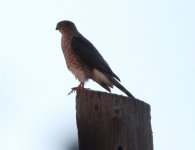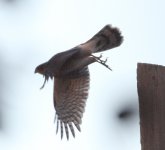-
Welcome to BirdForum, the internet's largest birding community with thousands of members from all over the world. The forums are dedicated to wild birds, birding, binoculars and equipment and all that goes with it.
Please register for an account to take part in the discussions in the forum, post your pictures in the gallery and more.
You are using an out of date browser. It may not display this or other websites correctly.
You should upgrade or use an alternative browser.
You should upgrade or use an alternative browser.
Sharp-shinned Hawk? - Winnipeg, Manitoba (1 Viewer)
- Thread starter khustochka
- Start date
More options
Who Replied?I don't see this. Legs this thin can only mean Sharpie surely, and general rounded sparrowhawk jizz good for that too. Suggest wing tips slightly longer than vent better for sharpie (but not as clear-cut as Sibley illustrations).But pale sides to hindneck (peering through the underexposure) mean Cooper's hawk.
I count the leg-thickness feature as the most-useless of all the well-known criteria. In any event, as I understand it, it is only to be used when viewing from the front or back - the difference being due to the fact that the legs of sharp-shinned hawk are laterally flattened.
nartreb
Speak softly and carry a long lens
Both species have legs that are skinniest when viewed from the front. The legs are practically identical when viewed from the side, and extremely hard to judge when viewed from the front, too.
I see Butty's point about a pretty strong cap contrast which should mean Coop, but I can't get past my initial impression that the whole bird is small and rounded, with general Sharpie proportions. Tail shape is hard to judge in the flight shot, but it does seem to show the outer feathers are shorter than the rest --- so it's a Coop after all.
I see Butty's point about a pretty strong cap contrast which should mean Coop, but I can't get past my initial impression that the whole bird is small and rounded, with general Sharpie proportions. Tail shape is hard to judge in the flight shot, but it does seem to show the outer feathers are shorter than the rest --- so it's a Coop after all.
There is (was?) a jolly interesting webpage/blog/whatever-thing by Sibley, with lots of photos, detailing why trying to judge the tail-tip shape of both species in flight is so unreliable as to be a waste of time. I can't find it.Tail shape is hard to judge in the flight shot...
Last edited:
To be honest, unless some US hawk mavern steps in, probably best least un-id'd. I don't see the same neck features Butty sees (perhaps playing with the exposure/contrast might help), and you'll see my notes on wing/vent above
Edit: not to second guess, but I understand Butty's comments to be about the neck sides not the cap. I don't see a strong (any?) cap contrast here)
Edit: not to second guess, but I understand Butty's comments to be about the neck sides not the cap. I don't see a strong (any?) cap contrast here)
Last edited:
Taking another look at this, the sides of the hindneck do look quite dark, if (apparently) not as dark as the rear of the neck - but in such an underexposed photo I'm sure of nothing. In combination, however, with the smallish bill + steepish forehead, I now suspect this to be sharp-shinned hawk.
nartreb
Speak softly and carry a long lens
I think we're talking about the same contrast; if the nape is pale it helps the cap to stand out. The nape does look pale in the photo but it's not nearly as clear - cut as I'd like. Sharp-shin does frequently show some contrast between cap and neck, it's a question of how sharp and strong the border is, and/or just how pale the neck is, and given the iffy lighting, this photo is not very convincing either way.
There's pretty clearly one outer tail feather shorter than all the others (nothing to do with angle of spread, it's largely overlapping its neighbor), and I think I see the same on the other side, but I can't find the sibley blog that Butty references. Multiple sources (here's one) indicate that r6 < r1 is diagnostic for coopers, though the differences can be small and subject to molt.
There's pretty clearly one outer tail feather shorter than all the others (nothing to do with angle of spread, it's largely overlapping its neighbor), and I think I see the same on the other side, but I can't find the sibley blog that Butty references. Multiple sources (here's one) indicate that r6 < r1 is diagnostic for coopers, though the differences can be small and subject to molt.
I fear that your source doesn't say that - that's a misinterpretation of the text. In any case, I would be worried if any source said that - as sharp-shinned hawk not-uncommonly has the outermost feathers (a bit) shorter than the others and thus has 'r6 < r1'; this is why there is potential for confusion in using the tail-tip-structure feature. Even that source says: 'There are Sharpies that exhibit fairly rounded tail tips'.Multiple sources (here's one) indicate that r6 < r1 is diagnostic for coopers
(Is 'r' = rectrix, really used as an abbreviation meaning tail-feather in N America - when the potential for confusion with remige = primaries+secondaries is so obvious? Most unwise.)
nartreb
Speak softly and carry a long lens
You're right, I left out an adverb: that source says that in Coop's the rectrix 6 is (usually) "obviously" shorter than r1 (whereas any difference in sharpie is never obvious). Looking at the "top" (bird's leftmost) feather in the photo, compared to the feather it overlaps, I think the difference qualifies as "obvious".
The word that I use, and prefer, in that context is 'substantially' (still a subjective one of course) - but, yes, the point is as you describe it.the rectrix 6 is (usually) "obviously" shorter than r1 (whereas any difference in sharpie is never obvious).
I fear that your source doesn't say that - that's a misinterpretation of the text. In any case, I would be worried if any source said that - as sharp-shinned hawk not-uncommonly has the outermost feathers (a bit) shorter than the others and thus has 'r6 < r1'; this is why there is potential for confusion in using the tail-tip-structure feature. Even that source says: 'There are Sharpies that exhibit fairly rounded tail tips'.
(Is 'r' = rectrix, really used as an abbreviation meaning tail-feather in N America - when the potential for confusion with remige = primaries+secondaries is so obvious? Most unwise.)
The singular of remiges is remex not remige!remige = primaries+secondaries
Excellent! 🏅🏆🏅 - thank you 👍🏻singular of remiges is remex
Now I shall know how to use that redundant elitist term correctly if I'm ever driven to do so in future.
I don't think there is any confusion when 'r6' (or similar) is used to indicate a particular rectrix. For remiges it would be 'p6' for a primary or 's6' for a secondary; 'r6' would have no clear meaning if applied to a remige (or a remex, if you like).(Is 'r' = rectrix, really used as an abbreviation meaning tail-feather in N America - when the potential for confusion with remige = primaries+secondaries is so obvious? Most unwise.)
That wasn't really my point...
p = primary - pretty obvious and unambiguous.
s = secondary - pretty obvious and unambiguous.
r = ...what? Unless you just happen to be serious enough to be into the arcane end of birding/museum/ringing terminology, you won't have a clue. And, if you happen to have some degree of a clue, you have then got two 'r' options. Hence ambiguity. For inclusivity and to minimise elitism, intuitiveness is the key - and there ain't nothing intuitive about 'r', especially when 't' is way clearer to people with way less knowledge.
p = primary - pretty obvious and unambiguous.
s = secondary - pretty obvious and unambiguous.
r = ...what? Unless you just happen to be serious enough to be into the arcane end of birding/museum/ringing terminology, you won't have a clue. And, if you happen to have some degree of a clue, you have then got two 'r' options. Hence ambiguity. For inclusivity and to minimise elitism, intuitiveness is the key - and there ain't nothing intuitive about 'r', especially when 't' is way clearer to people with way less knowledge.
This comes from a paper that was written for just such people and where, even so, it was explained that 'r' meant rectrix. I do not see that using 'r" for 'tail feather' is any less clear than 'p' for 'outer wing feather' and 's' for 'inner wing feather'.That wasn't really my point...
p = primary - pretty obvious and unambiguous.
s = secondary - pretty obvious and unambiguous.
r = ...what? Unless you just happen to be serious enough to be into the arcane end of birding/museum/ringing terminology, you won't have a clue. And, if you happen to have some degree of a clue, you have then got two 'r' options. Hence ambiguity. For inclusivity and to minimise elitism, intuitiveness is the key - and there ain't nothing intuitive about 'r', especially when 't' is way clearer to people with way less knowledge.
I heard that there are 2 systems of numbering primary feathers and each goes in the opposite direction. Also that some people drive on the right...This comes from a paper that was written for just such people and where, even so, it was explained that 'r' meant rectrix. I do not see that using 'r" for 'tail feather' is any less clear than 'p' for 'outer wing feather' and 's' for 'inner wing feather'.
None of this is confusing of course: it's designed to facilitate communication, peace and inner harmony. Or something
Users who are viewing this thread
Total: 2 (members: 0, guests: 2)






